反倾销反补贴保障和特殊情况处理等(中英文对照)
- 格式:docx
- 大小:17.15 KB
- 文档页数:5
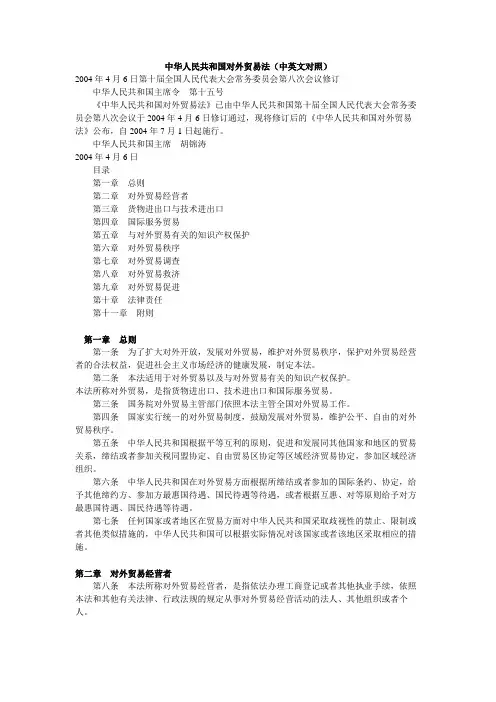
中华人民共和国对外贸易法(中英文对照)2004年4月6日第十届全国人民代表大会常务委员会第八次会议修订中华人民共和国主席令第十五号《中华人民共和国对外贸易法》已由中华人民共和国第十届全国人民代表大会常务委员会第八次会议于2004年4月6日修订通过,现将修订后的《中华人民共和国对外贸易法》公布,自2004年7月1日起施行。
中华人民共和国主席胡锦涛2004年4月6日目录第一章总则第二章对外贸易经营者第三章货物进出口与技术进出口第四章国际服务贸易第五章与对外贸易有关的知识产权保护第六章对外贸易秩序第七章对外贸易调查第八章对外贸易救济第九章对外贸易促进第十章法律责任第十一章附则第一章总则第一条为了扩大对外开放,发展对外贸易,维护对外贸易秩序,保护对外贸易经营者的合法权益,促进社会主义市场经济的健康发展,制定本法。
第二条本法适用于对外贸易以及与对外贸易有关的知识产权保护。
本法所称对外贸易,是指货物进出口、技术进出口和国际服务贸易。
第三条国务院对外贸易主管部门依照本法主管全国对外贸易工作。
第四条国家实行统一的对外贸易制度,鼓励发展对外贸易,维护公平、自由的对外贸易秩序。
第五条中华人民共和国根据平等互利的原则,促进和发展同其他国家和地区的贸易关系,缔结或者参加关税同盟协定、自由贸易区协定等区域经济贸易协定,参加区域经济组织。
第六条中华人民共和国在对外贸易方面根据所缔结或者参加的国际条约、协定,给予其他缔约方、参加方最惠国待遇、国民待遇等待遇,或者根据互惠、对等原则给予对方最惠国待遇、国民待遇等待遇。
第七条任何国家或者地区在贸易方面对中华人民共和国采取歧视性的禁止、限制或者其他类似措施的,中华人民共和国可以根据实际情况对该国家或者该地区采取相应的措施。
第二章对外贸易经营者第八条本法所称对外贸易经营者,是指依法办理工商登记或者其他执业手续,依照本法和其他有关法律、行政法规的规定从事对外贸易经营活动的法人、其他组织或者个人。
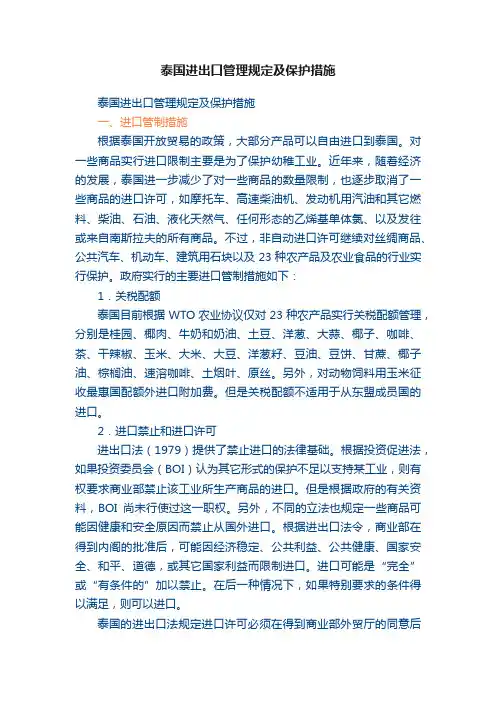
泰国进出口管理规定及保护措施泰国进出口管理规定及保护措施一、进口管制措施根据泰国开放贸易的政策,大部分产品可以自由进口到泰国。
对一些商品实行进口限制主要是为了保护幼稚工业。
近年来,随着经济的发展,泰国进一步减少了对一些商品的数量限制,也逐步取消了一些商品的进口许可,如摩托车、高速柴油机、发动机用汽油和其它燃料、柴油、石油、液化天然气、任何形态的乙烯基单体氯、以及发往或来自南斯拉夫的所有商品。
不过,非自动进口许可继续对丝绸商品、公共汽车、机动车、建筑用石块以及23种农产品及农业食品的行业实行保护。
政府实行的主要进口管制措施如下:1.关税配额泰国目前根据WTO农业协议仅对23种农产品实行关税配额管理,分别是桂园、椰肉、牛奶和奶油、土豆、洋葱、大蒜、椰子、咖啡、茶、干辣椒、玉米、大米、大豆、洋葱籽、豆油、豆饼、甘蔗、椰子油、棕榈油、速溶咖啡、土烟叶、原丝。
另外,对动物饲料用玉米征收最惠国配额外进口附加费。
但是关税配额不适用于从东盟成员国的进口。
2.进口禁止和进口许可进出口法(1979)提供了禁止进口的法律基础。
根据投资促进法,如果投资委员会(BOI)认为其它形式的保护不足以支持某工业,则有权要求商业部禁止该工业所生产商品的进口。
但是根据政府的有关资料,BOI尚未行使过这一职权。
另外,不同的立法也规定一些商品可能因健康和安全原因而禁止从国外进口。
根据进出口法令,商业部在得到内阁的批准后,可能因经济稳定、公共利益、公共健康、国家安全、和平、道德,或其它国家利益而限制进口。
进口可能是“完全”或“有条件的”加以禁止。
在后一种情况下,如果特别要求的条件得以满足,则可以进口。
泰国的进出口法规定进口许可必须在得到商业部外贸厅的同意后货物才能到港。
对进口许可管制的商品品种及申请条件的改变都通过政府公告通知,并在泰国银行季度公报中公布,进口管理的有关规定若有任何变化,则通过政府公告或报纸以及国家广播公布。
二、出口管制和保护措施在过去的几年里,政府取消了对一些出口商品的配额管理,而增加了从融资方面给予企业的支持力度。
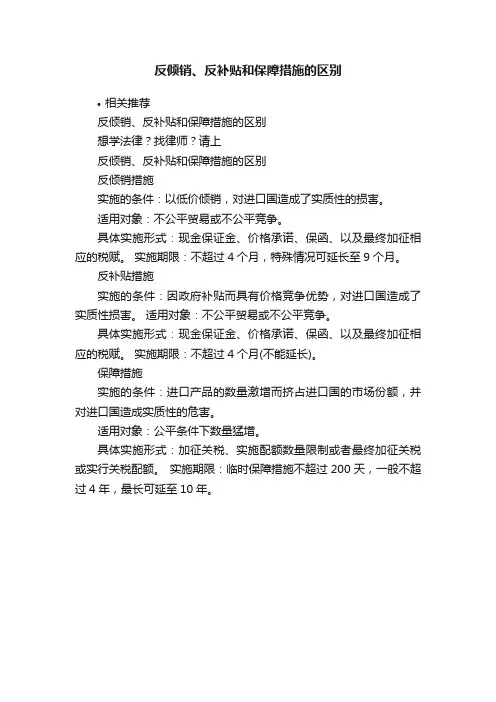
反倾销、反补贴和保障措施的区别
•相关推荐
反倾销、反补贴和保障措施的区别
想学法律?找律师?请上
反倾销、反补贴和保障措施的区别
反倾销措施
实施的条件:以低价倾销,对进口国造成了实质性的损害。
适用对象:不公平贸易或不公平竞争。
具体实施形式:现金保证金、价格承诺、保函、以及最终加征相应的税赋。
实施期限:不超过4个月,特殊情况可延长至9个月。
反补贴措施
实施的条件:因政府补贴而具有价格竞争优势,对进口国造成了实质性损害。
适用对象:不公平贸易或不公平竞争。
具体实施形式:现金保证金、价格承诺、保函、以及最终加征相应的税赋。
实施期限:不超过4个月(不能延长)。
保障措施
实施的条件:进口产品的数量激增而挤占进口国的市场份额,并对进口国造成实质性的危害。
适用对象:公平条件下数量猛增。
具体实施形式:加征关税、实施配额数量限制或者最终加征关税或实行关税配额。
实施期限:临时保障措施不超过200天,一般不超过4年,最长可延至10年。
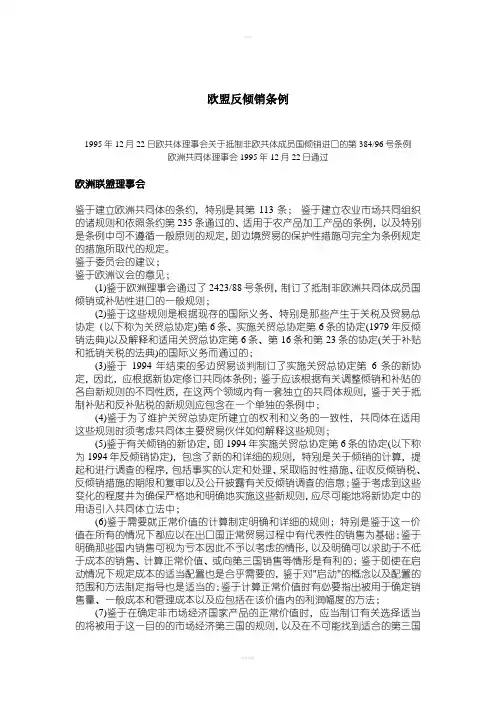
欧盟反倾销条例1995年12月22日欧共体理事会关于抵制非欧共体成员国倾销进口的第384/96号条例欧洲共同体理事会1995年12月22日通过欧洲联盟理事会鉴于建立欧洲共同体的条约,特别是其第113条;鉴于建立农业市场共同组织的诸规则和依照条约第235条通过的、适用于农产品加工产品的条例,以及特别是条例中可不遵循一般原则的规定,即边境贸易的保护性措施可完全为条例规定的措施所取代的规定。
鉴于委员会的建议;鉴于欧洲议会的意见;(1)鉴于欧洲理事会通过了2423/88号条例,制订了抵制非欧洲共同体成员国倾销或补贴性进口的一般规则;(2)鉴于这些规则是根据现存的国际义务、特别是那些产生于关税及贸易总协定(以下称为关贸总协定)第6条、实施关贸总协定第6条的协定(1979年反倾销法典)以及解释和适用关贸总协定第6条、第16条和第23条的协定(关于补贴和抵销关税的法典)的国际义务而通过的;(3)鉴于1994年结束的多边贸易谈判制订了实施关贸总协定第6条的新协定,因此,应根据新协定修订共同体条例;鉴于应该根据有关调整倾销和补贴的各自新规则的不同性质,在这两个领域内有一套独立的共同体规则,鉴于关于抵制补贴和反补贴税的新规则应包含在一个单独的条例中;(4)鉴于为了维护关贸总协定所建立的权利和义务的一致性,共同体在适用这些规则时须考虑共同体主要贸易伙伴如何解释这些规则;(5)鉴于有关倾销的新协定,即1994年实施关贸总协定第6条的协定(以下称为1994年反倾销协定),包含了新的和详细的规则,特别是关于倾销的计算,提起和进行调查的程序,包括事实的认定和处理、采取临时性措施、征收反倾销税、反倾销措施的期限和复审以及公开披露有关反倾销调查的信息;鉴于考虑到这些变化的程度并为确保严格地和明确地实施这些新规则,应尽可能地将新协定中的用语引入共同体立法中;(6)鉴于需要就正常价值的计算制定明确和详细的规则;特别是鉴于这一价值在所有的情况下都应以在出口国正常贸易过程中有代表性的销售为基础;鉴于明确那些国内销售可视为亏本因此不予以考虑的情形,以及明确可以求助于不低于成本的销售、计算正常价值、或向第三国销售等情形是有利的;鉴于即使在启动情况下规定成本的适当配置也是合乎需要的,鉴于对"启动"的概念以及配置的范围和方法制定指导也是适当的;鉴于计算正常价值时有必要指出被用于确定销售量、一般成本和管理成本以及应包括在该价值内的利润幅度的方法;(7)鉴于在确定非市场经济国家产品的正常价值时,应当制订有关选择适当的将被用于这一目的的市场经济第三国的规则,以及在不可能找到适合的第三国时,可在任何其他合理的基础上来确定正常价值的规则;(8)鉴于确定出口价格和在有必要从第一次公开市场价格出发重新推算出口价格的情形下列举某些调整项目是有益的;(9)鉴于为保证在出口价格与正常价值之间进行公平比较,应列举可能影响价格和价格可比性的那些因素,应制定有关何时及如何进行调整的明确规则,包括应避免任何重复调整的规则;鉴于虽然各个出口价格因其客户、地区或期限等原因不同时仍可以与平均正常价值进行对比,但也有必要规定,可以使用平均价格比较出口价格和正常价值;(10)鉴于应制订明确、详细的规则指导那些与确定倾销进口商品是否已造成实质性损害或实质性损害的威胁有关的因素;鉴于在证明有关进口商品的数量和价格水平对共同体某一产业所遭受的损害负有责任时,应注意其他因素特别是共同体现有市场条件的作用;(11)鉴于应限定"共同体产业"这一术语,应规定与出口商有关联的当事人应从"产业"中排除以及应限定"关联"一词的含义;鉴于有必要规定以共同体某个地区的生产者的名义提起反倾销,以及有必要对该地区的定义制订指南;(12)鉴于有必要规定可以提起反倾销申请的当事人,包括共同体产业应该支持的程度,以及该申请应包括的有关倾销、损害和因果关系的信息;鉴于应规定有关驳回申请或者开始调查的程序;(13)鉴于有必要规定利害当事人应得到关于当局所需信息的通知,应有充分机会去提供所有相关证据及维护其利益的方法;鉴于应明确制定在调查期间应遵循的那些规则和程序,特别是如果利害当事人的意见和信息将被调查机关考虑,利害当事人在一个特定期限内据以进行自我通报、发表意见和提供信息的那些规则;鉴于应规定在哪些情形下利害当事人可以获得并评论由其他利害当事人所提供的信息的;鉴于在收集信息方面成员国和委员会之间应当进行合作;(14)鉴于有必要规定征收临时反倾销税的条件,包括这种征收不早于开始调查之日起60天和不晚于此日后9个月的条件;鉴于因行政管理的原因,有必要规定反倾销税由委员会征收,或者直接征收期限为9个月的临时反倾销税或者征收期限为6个月和3个月两个阶段的临时反倾销税;(15)鉴于有必要规定接受消除倾销和损害的承诺以代替征收临时或最终反倾销税的程序;鉴于应规定违反或者撤销承诺的后果,以及在有违反承诺之嫌或者需要进一步调查以补充调查结果情况下可以征收临时反倾销税;鉴于在接受承诺时应注意提出的承诺及其实施不会导致反竞争的行为;(16)鉴于有必要规定不论是否采取最终措施,案件通常应在开始调查之日起12个月内结束,并决不能超过15个月;鉴于在微量倾销或在损害可予忽略不计时,应终止调查或者诉讼,应对这些术语予以定义;鉴于在征收反倾销税时,有必要规定终止调查,在征收较少数额的反倾销税就可消除损害的情况下,有必要规定反倾销税应低于倾销幅度,以及有必要规定在抽样的情况下计算反倾销税程度的办法;(17)鉴于有必要规定如认为适当时可追溯征收临时反倾销税,有必要说明那些可能引起追溯适用反倾销税以免削弱将适用的最终反倾销措施的情况;鉴于也有必要规定反倾销税可追溯适用于违反或者撤销承诺的情况;(18)鉴于有必要规定反倾销措施5年后将终止,除非复审调查表明这些措施应继续实施;鉴于在有充分证据表明情况已变化的场合,应规定临时复审或调查,以确定是否同意退还反倾销税;鉴于作出以下的规定也是合适的,在重新计算倾销致使有必要重新计算出口价格时,如该反倾销税反映在受共同体反倾销制裁的商品的价格上,则该反倾销税不应作为在进口和转卖期间发生的成本;(19)鉴于在出口商通过补偿安排方式承受反倾销税和反倾销措施没有反映在受共同体反倾销制裁的商品的价格上时,有必要对出口价格和倾销幅度的重新估算作出特别规定;(20)鉴于尽管一个单独的关贸总协定部长决议承认规避是个问题并已将其提交到关贸总协定反倾销委员会去解决,但1994年反倾销协定并没有包括关于规避反倾销措施的条款;鉴于迄今在此问题上多边谈判的失败和关贸总协定反倾销委员会对此还未作出结论,从而有必要在共同体立法中增加新的条款,以解决包括在共同体内或者在第三国内进行的以规避反倾销措施为主要目的货物组装在内的做法;(21)鉴于在市场条件出现暂时性变化,使继续征收反领销税暂时显得不合适的情况下,允许中止反倾销措施是可取的;(22)鉴于有必要规定被调查的进口货物进口时应当登记,以便随后能够对这些进口货物适用反倾销措施;(23)鉴于为确保正确实施反倾销措施,成员国必须监督并向委员会报告被调查的或被实施反倾销措施的产品的进口贸易以及依照本规则所征收的反倾销税数额;(24)鉴于有必要规定,定期地或在特殊的调查阶段,同咨询委员会协商;鉴于该委员会应当由成员国的代表组成并由委员会的一名代表担任主席;(25)鉴于应规定进行实地核查以审核当事人提供的有关倾销和损害的信息,但实地核察应以收到对调查问卷的合适答复为条件;(26)鉴于应在当事人或者交易数目巨大的情况下规定抽样的调查方法以在法定的期限内完成调查;(27)鉴于有必要规定,在当事人不能令人满意地进行配合时,可以使用其他信息作出裁定,与当事人相配合的情况比,该信息可能对该当事人较为不利;(28)鉴于有必要对处理机密信息作出规定以便商业秘密不被泄漏;(29)鉴于应规定向那些有权得到这种待遇的当事人适当披露基本事实和审议;鉴于这种披露应适当考虑共同体内作出决定的过程,并在允许当事人维护自身利益的期限内进行;(30)鉴于应当建立一个解决争议的行政机构,有关反倾销措施是否符合包括消费者利益在内的共同体利益的争议可由它解决;应规定一个提供这类信息和有关当事人的知情权的期限;(31)鉴于理事会通过制定1994年12月22日欧共体关于抵制非欧共体成员国倾销进口的第3283/94号规则,废降了欧洲经济共同体第2423/88号规则,并建立了一个新的抵彻非欧共体成员国倾销进口的共同制度;(32)鉴于欧共体第3283/94号规则条文中的重大错误在公布时很明显;(33)此外,鉴于该规则已经两次修改;(34)鉴于为了法律的清楚、透明和法律确定性,该规则因此应被废除和取代,但这不影响根据该规则或根据欧洲经济共同体第2423/88号规则已提起的反倾销诉讼。
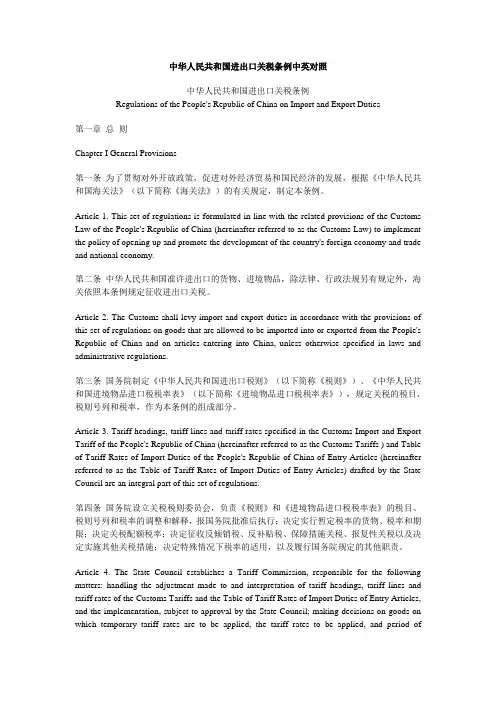
中华人民共和国进出口关税条例中英对照中华人民共和国进出口关税条例Regulations of the People's Republic of China on Import and Export Duties第一章总则Chapter I General Provisions第一条为了贯彻对外开放政策,促进对外经济贸易和国民经济的发展,根据《中华人民共和国海关法》(以下简称《海关法》)的有关规定,制定本条例。
Article 1. This set of regulations is formulated in line with the related provisions of the Customs Law of the People's Republic of China (hereinafter referred to as the Customs Law) to implement the policy of opening up and promote the development of the country's foreign economy and trade and national economy.第二条中华人民共和国准许进出口的货物、进境物品,除法律、行政法规另有规定外,海关依照本条例规定征收进出口关税。
Article 2. The Customs shall levy import and export duties in accordance with the provisions of this set of regulations on goods that are allowed to be imported into or exported from the People's Republic of China and on articles entering into China, unless otherwise specified in laws and administrative regulations.第三条国务院制定《中华人民共和国进出口税则》(以下简称《税则》)、《中华人民共和国进境物品进口税税率表》(以下简称《进境物品进口税税率表》),规定关税的税目、税则号列和税率,作为本条例的组成部分。
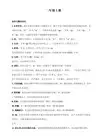
反倾销、反补贴、保障和特殊情况处理等(中英文对照)Anti-dumping, Subsidies, Safeguards,Contingencies, etc反倾销、反补贴、保障和特殊情况处理等英文来源:/english/thewto_e/whatis_e/tif_e/agrm8_e.htmBinding tariffs, and applying them equally to all trading partners (most-favoured-nation treatment, or MFN) are key to the smooth flow of trade in goods.约束关税及将其在全体贸易成员国之间平等地适用(即最惠国待遇,简称MFN)是保证商品交易过程畅通的关键。
The WTO agreementsuphold the principles, but they also allow exceptions — in some circumstances. Three of these issues are:世贸协议秉持着这些原则,但有时也有例外。
例如以下三种情况:actions taken against dumping (selling at an unfairly low price)1.反倾销(以不公平的低价出售商品的行为)措施;subsidies and special “countervailing” duties to offset the subsidies1.贸易补贴以及为抵消贸易补贴而征收的“反补贴”关税;emergency measures to limit imports temporarily, d esigned to “safeguard”domestic industries.1.为暂时限制进口以“保护”国内产业而采取的紧急应对措施。
Anti-dumping actions反倾销措施If a company exports a product at a price lower than the price it normally charges on its own home market, it is said to be “dumping” the product.如果某一公司以低于其在国内市场正常出售的价格出口某一产品,我们就称其“倾销”该产品。
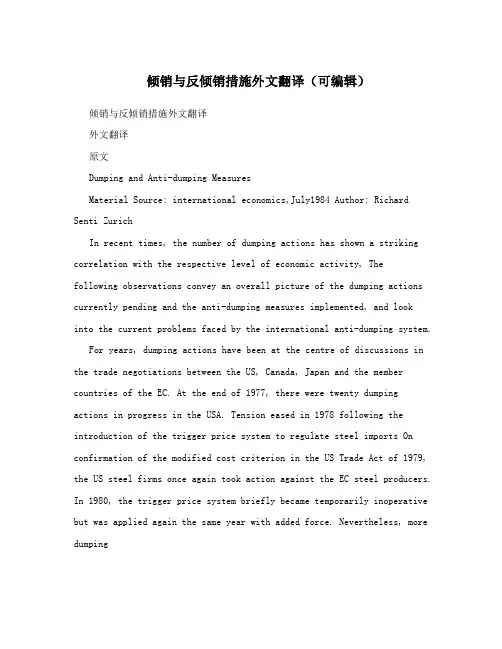
倾销与反倾销措施外文翻译(可编辑)倾销与反倾销措施外文翻译外文翻译原文Dumping and Anti-dumping MeasuresMaterial Source: international economics,July1984 Author: RichardSenti ZurichIn recent times, the number of dumping actions has shown a striking correlation with the respective level of economic activity, Thefollowing observations convey an overall picture of the dumping actions currently pending and the anti-dumping measures implemented, and lookinto the current problems faced by the international anti-dumping system.For years, dumping actions have been at the centre of discussions in the trade negotiations between the US, Canada, Japan and the member countries of the EC. At the end of 1977, there were twenty dumpingactions in progress in the USA. Tension eased in 1978 following the introduction of the trigger price system to regulate steel imports On confirmation of the modified cost criterion in the US Trade Act of 1979, the US steel firms once again took action against the EC steel producers. In 1980, the trigger price system briefly became temporarily inoperative but was applied again the same year with added force. Nevertheless, more dumpingactions followed,particularly in the years 1981 and 1982 At the beginning of 1983, the GATT Committee on Anti-Dumping Questions published a summary of theanti-dumping proceedings instituted during recent years in the USA, EC, Finland, Canada, Austria and Sweden,the provisional and definitive counter-measures and the price agreements reached cf. Table 1.The majority of actions are directed at the industrialised nations and only a few against the developing countries. Neither withdrawn actions nor those which resulted in a negative decision are included in these figures.Table 2 shows between which trade partners dumping negotiations took place during the years 1981/82, i.e. which countries instituted proceedings and which were sitting in the dock as far as was reported to GATT.US Anti-Dumping Legislation as a BasisIn 1945, immediately after the end of the war, the US State Department published the first proposals for a newworld trade order. According to these proposals, the members of an international trade organisation still to be created should, among other things,undertake "to 188 subscribe to a general definition of the circumstances under which anti-dumping and countervailing duties may properly be applied to products imported from other members".Only a year later, the Americans submitted the Charter for the Creation of an International Trade Organisation containing concretesuggestions on the anti-dumping settlement s which were later adopted by the Havana Charter s and GATT without undergoing significant alterations. Both the basic concept and many individual provisions are in line with the American antidumping legislation of that time.The first US anti-dumping provisions are to be found in the Revenue Act of 1916. 7 According to this law, the Americans imposed something akin to a fine 8 if 1 imports were offered in the USA at a lower price than in the country of origin and 2 as a result American industry was exposed to serious danger intent to destroy or injure. The two criteria "underpricing" and "infliction of damage" were later adopted by the actual anti-dumping laws of 1921 and 19309 and still apply todayfollowing the supplements and refinements made in 1974 and 1979.According to American Law of 1921 and 1930, dumping has occurred if the goods are offered more cheaply in the USA than on the home market price criterion. - Or, where there are no sales on the home market, if the goods are offered more cheaply in the USA than in a third country modified price criterion. - In case no sales are offered outside the country of destination, if the goods are exported below the costs of manufacture in the producing country cost criterion.The legal amendments of 1974 and 1979 brought with them an extension of the cost criterion to cover cases in which the domestic sales prices in the country of origin no longer cover the costs of productionOrigin of GATT Provisions and Anti-Dumping ConventionIn discussions surrounding the reshaping of the world trading system, 12 several delegates demanded going beyond the US regulation of price dumping of that time and incorporating service, exchange-rate and social dumping. Service dumping revolves around freight costs, i.e. the cheapening of exports by way of dumped transport services. Exchange-rate dumping is the cheapening of exports in the form of parity guaranteesand foreign exchange allowances. 13 Social dumping is constituted in cases where products from prison camps or prisons find their way ontothe world market at prices with which private entrepreneurs cannot compete. The negotiating delegations finally agreed on the price dumping in line with the US proposal.There were initial differences of opinion regarding the extent ofthe damage necessary for counter-measures to be taken. Must serious, material or indeterminate injury occur before counter-measures can be taken? Does the difference between domestic price and export price have to reach certain dimensions e.g. at least 5 % of the domestic price before counter-measures can be justified? Can serious injury caused be responded to with something like a punitive measure? Must the approvalof the ITO or of the contracting parties to GATT be obtained before counter-measuresare taken? The formulation finally agreed upon states thatcountermeasures may only be taken if the contracting partyestablishes "that the effect of the dumping.., is such as to cause orthreaten material injury to an established domestic industry, or is such as to retard materially the establishment of a domestic industry". TM In 1955, Article VI of GATT was supplemented the first and only amendment to the GATT wording on dumping to the effect that in cases where delay might cause "damage that would be difficult to repair", immediate measures are permitted without the need to seek the prior consent of the contracting parties to GATT. 15The dumping question experienced a revival during the Kennedy Round between 1964 and 1967. TheAmericans had tried to include also non-tariff barriers in the trade talks. Subsequently, they realised much to their annoyance that the negotiating parties werespotlighting the verybarriers to trade which applied in the USA, above all the US anti-dumping law. After brief hesitation, the Americans attempted to turn the antidumping controversy in their favour with the help of a detailed regulation. Thus emerged the Anti-Dumping Code of 1967 which, althoughit ties the Americans' hands in many a procedural question, otherwise hitsparticularly hard at Canada and Great Britain.Canada's anti-dumping legislation up to that time did not conform to GATT in that the taking of anti-dumping measures was not bound to the precondition of economic damage. Also in Great Britain - accordingto the American view- anti-dumping measures at that time were being misused for the protection of the domestic economy. From the US perspective, the advantages associated with the Anti-Dumping Codeoutweighed the resultant disadvantages which it was felt had to be accepted.The "Agreement on Implementation of Article VI of the General Agreement on Tariffs and Trade Anti-Dumping Code" is dated 30th June, 1967.16 During the Tokyo Round, the 1967 Anti-Dumping Code underwent a two-fold amendment: firstly, there was the question of demarcation vis-a-vis the Code on Subsidies and Countervailing Duties which was in the process of formation; 17 secondly, changes were made to the existing agreement in terms of ascertainment of damage Art. 3: 1-4, theprivileged position of the developing countries Art. 13 and consultations, arbitration and settlement of disputes Art. 15. 18 The currently valid agreement on anti-dumping was reached on 12th April 1979 in Geneva. ~9 Wherever the antidumping agreement is mentioned in the following, reference is being made to the currently valid version of 1979.Definition of DumpingIn imitation of the American legal system of the 20s and 30s, GATT speaks of dumping when products of the same kind "of one country are introduced into the commerce of another country at less than the normal value of the products". Hence,dumping means that the "normal" domestic value of an article exceeds its export value. How does GATT define the "normal" domestic value? When is a product "of the same kind" when compared with another? How should we interpret export value?The "normal" value of an article is undercut according to Art. VI:Iof GATT "if the price of the product exported from one country toanother a is less than the comparable price, in the ordinary course of trade, for the like product when destined for consumption in theexporting country, or b in the absence of such domestic price, is less than either i the highest comparable price for the like product forexport to any third country in the ordinary course of trade, or ii the cost of proddction of the product in the country of origin plus a reasonable addition for selling cost and profit".Differences in terms and conditions of sale, varying taxation andother differentials influencing the price are to be given "due" consideration. On the other hand, however, if export prices are lower because of the reimbursement of domestic duties and taxes e.g. by way of the reimbursement of VAT, this does not, according to GATT, constitute dumping which would justify counter-measures. The "normal" domesticvalue is taken to be exclusive of duties and taxes The GATT definitionof dumping applies to all countries which are signatories to GATT -apart from one important exception. The US anti-dumping law contains divergent and partly narrower provisions than GATT in two specific areas: Should the export product come to be sold in the country of origin, GATT says that dumping is to be determined according to the pricecriterion irrespective of the extent of the costs of manufacture. According to American law, however, the costs of manufacture can also be taken into consideration as well as the domestic price. The costcriterion shall apply in cases where there is good reason to supposethat the domestic price remains lower than the costs of manufacture for substantial quantities of merchandise over a relatively long period of time In this way, the Americans succeed in shielding the market from merchandise which has been falsely priced as a result of any production cost contributions, or in taxing them with anti-dumping duties. They refute the GATT contravention of which they are accused with the argument that GATT talks in terms of "normal" domestic prices. Normal prices, however, cannot be lower than costs of manufacture over longer periods. This is why, in the case of price undercutting over longer periods, the cost criterion should be applied In applying the cost criterion, the export prices are, according to GATT, to be compared with the cost of production "plus a reasonable addition for selling cost and profit". The addition for profit "shall not exceed the profit normally realised on sales of products of the same general category in the domestic market of the country of origin". By way of contrast, the US anti-dumping law defines the costs taken as a basis for comparison as follows: 1 material andproduction costs, 2overheads of not less than 10 % of the material and production costs, 3 profit margin of not less than 8 % of the costs mentioned in points 1 and 2, and 4 packing and loading expenses as defined under the f.o.b, price.When are goods described as being of the same kind? The American proposal of 1 946 for the creation of a world trade organisation spokeof the "like" and "similar" products. 26 During the subsequent negotiations it was decided to limit the definition to "like" products, products which are identical, homogeneous In practice, however, this terminology proved to be impracticable. Slight divergences of quality or differing forms or colourings do not rule out competition nor hence the possibility of dumping. To make allowance for this fact, the Anti-dumping Code holds that such goods are also included which "although not alike in all respects, have characteristics closely resembling those of the product under consideration"译文倾销与反倾销措施资料来源: 国际经济学,1984年7月作者:Richard Senti Zurich在最近的时代,倾销行动的次数已经呈现出与各自的经济活动水平显着相关性,以下意见反映了目前未决诉讼和反倾销措施实施的总体情况,并查看到当前面临的国际反倾销制度问题。
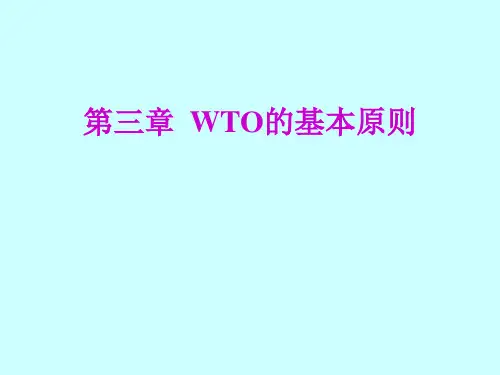
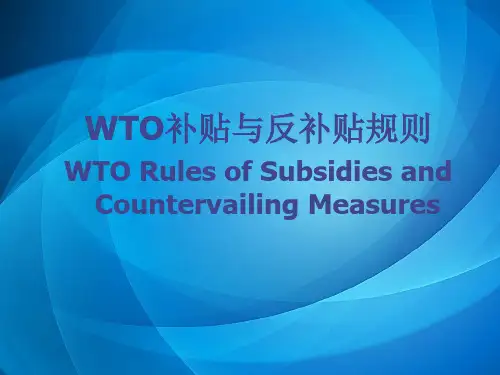
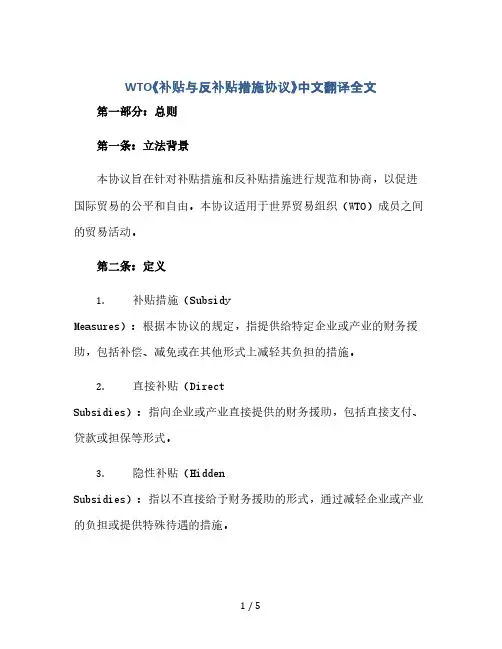
WTO《补贴与反补贴措施协议》中文翻译全文第一部分:总则第一条:立法背景本协议旨在针对补贴措施和反补贴措施进行规范和协商,以促进国际贸易的公平和自由。
本协议适用于世界贸易组织(WTO)成员之间的贸易活动。
第二条:定义1.补贴措施(SubsidyMeasures):根据本协议的规定,指提供给特定企业或产业的财务援助,包括补偿、减免或在其他形式上减轻其负担的措施。
2.直接补贴(DirectSubsidies):指向企业或产业直接提供的财务援助,包括直接支付、贷款或担保等形式。
3.隐性补贴(HiddenSubsidies):指以不直接给予财务援助的形式,通过减轻企业或产业的负担或提供特殊待遇的措施。
4.反补贴措施(CountervlingMeasures):根据本协议的规定,指针对其他成员国的补贴措施采取的合法行动。
第三条:原则1.公平贸易(FrTrade):成员国应在贸易活动中遵循公平原则,不得利用补贴措施给其他成员国的企业或产业造成不正当的竞争优势。
2.透明度(Transparency):成员国应保持透明,及时通报补贴措施和相关信息,确保其他成员国了解措施的性质和影响。
3.互惠原则(Reciprocity):成员国之间应相互尊重和平衡的参与补贴措施,平等对待其他成员国。
第二部分:补贴措施的规定第四条:补贴措施的禁止1.除非符合例外规定,补贴措施应被视为禁止。
2.隐性补贴应被视为直接补贴。
3.例外规定包括国家发展计划、环保和区域发展等特殊情况。
成员国若认为其他成员国的补贴措施对其企业或产业造成不利影响,应提供充足的证据支持其主张。
第六条:补贴措施的通知成员国应及时向WTO通报其所有的补贴措施,包括直接补贴和隐性补贴的信息。
第七条:补贴措施的审查1.成员国可向WTO请求对其他成员国的补贴措施进行审查,如发现有利于企业或产业的不公平补贴。
2.审查应基于提供的证据,并遵循透明和公正的原则。
第八条:补贴措施的争端解决如发生争端,成员国应使用争端解决机制解决补贴措施的争议。
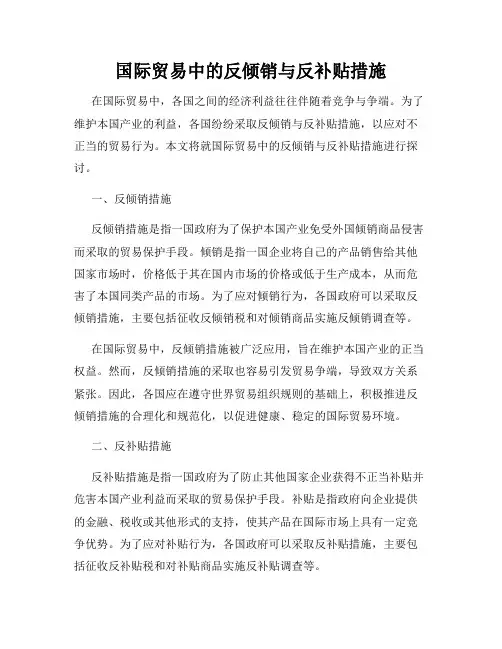
国际贸易中的反倾销与反补贴措施在国际贸易中,各国之间的经济利益往往伴随着竞争与争端。
为了维护本国产业的利益,各国纷纷采取反倾销与反补贴措施,以应对不正当的贸易行为。
本文将就国际贸易中的反倾销与反补贴措施进行探讨。
一、反倾销措施反倾销措施是指一国政府为了保护本国产业免受外国倾销商品侵害而采取的贸易保护手段。
倾销是指一国企业将自己的产品销售给其他国家市场时,价格低于其在国内市场的价格或低于生产成本,从而危害了本国同类产品的市场。
为了应对倾销行为,各国政府可以采取反倾销措施,主要包括征收反倾销税和对倾销商品实施反倾销调查等。
在国际贸易中,反倾销措施被广泛应用,旨在维护本国产业的正当权益。
然而,反倾销措施的采取也容易引发贸易争端,导致双方关系紧张。
因此,各国应在遵守世界贸易组织规则的基础上,积极推进反倾销措施的合理化和规范化,以促进健康、稳定的国际贸易环境。
二、反补贴措施反补贴措施是指一国政府为了防止其他国家企业获得不正当补贴并危害本国产业利益而采取的贸易保护手段。
补贴是指政府向企业提供的金融、税收或其他形式的支持,使其产品在国际市场上具有一定竞争优势。
为了应对补贴行为,各国政府可以采取反补贴措施,主要包括征收反补贴税和对补贴商品实施反补贴调查等。
在国际贸易中,反补贴措施的重要性日益凸显。
随着全球经济一体化的深入推进,各国之间的贸易关系日益紧密,而补贴行为往往容易引发贸易争端。
因此,各国政府应在加强国际合作的同时,采取有效的反补贴措施,防止不正当补贴扭曲国际市场秩序,维护国际贸易的公平竞争环境。
在总结上述内容时,我们可以看出,反倾销与反补贴措施在国际贸易中具有重要意义,对于维护各国产业的利益至关重要。
然而,反倾销与反补贴措施的采取也应遵守国际贸易规则,避免对其他国家的正当利益造成不必要的损害。
只有通过合作与规范,才能实现国际贸易的共赢局面,推动全球经济的持续繁荣与发展。
反倾销、反补贴、保障和特殊情况处理等(中英文对照)Anti-dumping, Subsidies, Safeguards,Contingencies, etc 反倾销、反补贴、保障和特殊情况处理等英文来源:/english/thewto_e/whatis_e/tif_e/agrm8_e.htmBinding tariffs, and applying them equally to all trading partners (most-favoured-nation treatment, or MFN) are key to the smooth flow of trade in goods. 约束关税及将其在全体贸易成员国之间平等地适用(即最惠国待遇,简称MFN )是保证商品交易过程畅通的关键。
The WTO agreementsuphold the principles, but they also allow exceptions —in some circumstances. Three of these issues are: 世贸协议秉持着这些原则,但有时也有例外。
例如以下三种情况:actions taken against dumping (selling at an unfairly low price)1. 反倾销(以不公平的低价出售商品的行为)措施;subsidies and special “ countervailing ” duties to offset the subsidies1. 贸易补贴以及为抵消贸易补贴而征收的“反补贴”关税;emergency measures to limit imports temporarily, d esigned to “ safeguarddomestic industries.1. 为暂时限制进口以“保护”国内产业而采取的紧急应对措施。
外贸英语中常见的税务词汇反倾销(Anti-Dumping)反倾销税(Anti-dumping Duties)从价关税(Ad Valorem Duties)单方面转移收支(Balance of Unilateral Transfers)多种汇率(Multiple Rates of Exchange)反补贴税(Counter Vailing Duties)从价(Ad Valorem)出厂价格(Cost Price)从量税(Specific Duty)初级产品(Primary Commodity)初级产品的价格(The Price of Primang Products)出口补贴(Export Subsidies)出口动物产品检疫(Quarantine of Export Animal products) 出口管制(Export Contral)出口税(Export Duty)保护关税(Protective Tariff)保税制度(Bonded System)布鲁塞尔估价定义(Brussels Definition of Value BDV)差别关税(Differential Duties)差价关税(Variable Import Levies)产品对产品减税方式(Product by Product Reduction of Tariff) 超保护贸易政策(Policy of Super-protection)成本(Cost)出口退税(Export Rebates)出口信贷(Export Finance)出口限制(Export Restriction)出口信贷国家担保制(Export credit Guarantee)出口许可证(Export Licence)储备货币(Reserve Carreacy)处于发展初级阶段(In the Early Etages of Development)处理剩余产品的指导原则(The Guiding Principle of Clealing With the Surplus Agricultural Products)关税(Customs Duty)关税和贸易总协定(The General Agreement On Tariffs And Trade)关税合作理事会(Customs Co-operation Council)关税减让(Tariff Concession)关税配额(Tariff Quota)关税升级(Tariff Escalation)关税水平(Tariff Level)关税税则(Tariff)关税同盟(Customs Union)关税和贸易总协定秘书处(Secretariat of GATT)国际价格(International Price)约束税率(Bound Rate)自主关税(Autonomous Tariff)最惠国税率(The Most-favoured-nation Rate of Duty)优惠差额(Margin of Preference)优惠税率(Preferential Rate)有效保护率(Effective Vate of Protection)https://www./。
W T O 简明术语(中英文对照)Ad valorem tariff 从价税Anti-dumping duty反倾销税Appeal(争端解决)上诉ATC--Agreement on Textiles and Clothing《纺织品与服装协议》Bound level约束水平Compensation补偿Consensus协商一致Consultation磋商Countervailing duty反补贴税Customs valuation 海关估价DSB--Dispute Settlement Body争端解决机构Dumping倾销Export subsidy出口补贴GATS--General Agreement on Trade in Service《服务贸易总协定》GATT--General Agreement on Tariff and Trade《关税与贸易总协定》Government procurement政府采购Import licencing进口许可Import substitution进口替代Import surcharge 进口附加税Market access市场准入Market price support市场价格支持Material injury实质损害MFN--Most-favored-nation treatment最惠国待遇National treatment国民待遇Non-actionable subsidy(补贴协议)不可诉补贴NTMs--Non-tariff measures非关税措施Plurilateral agreement诸边协议Prohibited subsidy(补贴协议)被禁止的补贴Protocols议定书PSI--Preshipment inspection装运前检验Rules of origin原产地规则Safeguard Measures保障措施Schedule of concessions承诺减让表Specific tariff从量税SPS --Sanitary and phytosanitary measures动植物卫生检疫措施Subsidy补贴Tariff binding关税约束承诺Tariffication 关税化TBT--Technical barriers to trade技术性贸易壁垒TPRM--Trade Policy Review Mechanism贸易政策审议机制Transparency透明度TRIMs--Trade-related investment measures与贸易有关的投资设施TRIPS--Trade related intellectual property rights与贸易有关的知识产权TRQ--Tariff rate quotas/tariff quotas关税配额Waiver(WTO义务的)豁免WTO--World Trading Organization世界贸易组织Ad valorem Tariff 从价onTextiles and Clothing (ATC) 《纺织品与服装协议》Anti-dumping Duty 反倾销税Arbitration 仲裁Balance-of-payments(BOP)Provisions 国际收支条款Ceiling Bindings (关税)上限约束Conciliation 调解Compensation 补偿Consensus 协商一致Countervailing Duty 反补贴税Customs Valuation 海关估价de minimis 微量Export Subsidy 出口补贴GATT1994 《1994年关税与贸易总协定》General Agreement on Trade in Services(GATS)《服务贸易总协定》General Exceptions 一般例外Illustrative List 例示清单Import Licensing 进口许可Import Surcharge 进口附加税Infant Industry 幼稚产业Intellectual Property Rights(IPRs)知识产权Market Access 市场准入National Treatment 国民待遇Non-actionable Subsidy 不可诉补贴Non-tariffs Measures(NTMs)非关税措施。
倾销类dumping 倾销antidumping 反倾销sporadic dumping 零星倾销persistent dumping 连续性倾销intermittent dumping 间歇性倾销predatory dumping 掠夺性倾销sales below producing cost 低于成本的销售domestic industry 国内产业normal value 正常价值material injury 实质损害ordinary course 正常贸易the like product 同类产品export price 出口价格margin of dumping 倾销幅度unreliable export price 出口价格不可靠reseanable basis 合理基础domestic price 出口国价格third-country price 第三国价格constructed price 结构价格non-market economy 非市场经济sufficient evidence 证据充分positive evidence 证据确凿objective examination 客观审查the consequent impact 随继影响a significant price undercutting 明显削价depress price 抑制价格clearly forseen 可预见的special care 小心谨慎cumulation of imports 累积进口问题all interested parties 所有利害关系人questionnare 调查表best information available (BIA) 最佳现有材料judicial review 司法审查consultation 磋商panel 专家组afford sympathetic consideration 给予审慎考虑complaining party 申诉方causation 因果关系principal cause 主要原因remedy measures 救济措施provisional antidumping duty 临时反倾销税provisional measures 临时措施preliminary affirmative determination 肯定性初裁definitive antidumping duties 最终反倾销税retroactive application of anti-dumping duties 追溯征收sunset clause 日落条款price under-taking 价格承诺补贴类subsidies 补贴specificity subsidies 专项性补贴actionable subsidies 可诉的补贴unactionable subsidies 不可诉的补贴prohibited subsides 禁止的补贴export performance 出口实绩adverse effect 负面影响public body 公共机构financial contribution 财政捐助safeguard clause 保障条款Committee on Subsidies and Contervailing Measures 补贴与反补贴委员会Permanent Group of Gxperts(PGE) 常设专家组Dispute Settlement Mechanism(DSM) 争端解决机制Dispute Settlement Body(DSB) 争端解决机构Appelate Body (AB) 上诉机构。
W T O 简明术语(中英文对照)Ad valorem tariff 从价税Agreement on Agriculture《农业协议》Anti-dumping duty反倾销税Appeal(争端解决)上诉ATC--Agreement on Textiles and Clothing《纺织品与服装协议》Bound level约束水平Compensation补偿Consensus协商一致Consultation磋商Countervailing duty反补贴税Customs valuation 海关估价DSB--Dispute Settlement Body争端解决机构Dumping倾销Export subsidy出口补贴GATS--General Agreement on Trade in Service《服务贸易总协定》GATT--General Agreement on Tariff and Trade《关税与贸易总协定》Government procurement政府采购Import licencing进口许可Import substitution进口替代Import surcharge 进口附加税Market access市场准入Market price support市场价格支持Material injury实质损害MFN--Most-favored-nation treatment最惠国待遇National treatment国民待遇Non-actionable subsidy(补贴协议)不可诉补贴NTMs--Non-tariff measures非关税措施Plurilateral agreement诸边协议Prohibited subsidy(补贴协议)被禁止的补贴Protocols议定书PSI--Preshipment inspection装运前检验Rules of origin原产地规则Safeguard Measures保障措施Schedule of concessions承诺减让表Specific tariff从量税SPS --Sanitary and phytosanitary measures动植物卫生检疫措施Subsidy补贴Tariff binding关税约束承诺Tariffication 关税化TBT--Technical barriers to trade技术性贸易壁垒TPRM--Trade Policy Review Mechanism贸易政策审议机制Transparency透明度TRIMs--Trade-related investment measures与贸易有关的投资设施TRIPS--Trade related intellectual property rights 与贸易有关的知识产权TRQ--Tariff rate quotas/tariff quotas关税配额Waiver(WTO义务的)豁免WTO--World Trading Organization世界贸易组织Ad valorem Tariff 从价onTextiles and Clothing (ATC) 《纺织品与服装协议》Anti-dumping Duty 反倾销税Arbitration 仲裁Balance-of-payments(BOP)Provisions 国际收支条款Ceiling Bindings (关税)上限约束Conciliation 调解Compensation 补偿Consensus 协商一致Countervailing Duty 反补贴税Customs Valuation 海关估价de minimis 微量Export Subsidy 出口补贴GATT1994 《1994年关税与贸易总协定》General Agreement on Trade in Services(GATS)《服务贸易总协定》General Exceptions 一般例外Illustrative List 例示清单Import Licensing 进口许可Import Surcharge 进口附加税Infant Industry 幼稚产业Intellectual Property Rights(IPRs)知识产权Market Access 市场准入National Treatment 国民待遇Non-actionable Subsidy 不可诉补贴Non-tariffs Measures(NTMs)非关税措施欢迎您的下载,资料仅供参考!致力为企业和个人提供合同协议,策划案计划书,学习资料等等打造全网一站式需求。
矿产资源开发利用方案编写内容要求及审查大纲
矿产资源开发利用方案编写内容要求及《矿产资源开发利用方案》审查大纲一、概述
㈠矿区位置、隶属关系和企业性质。
如为改扩建矿山, 应说明矿山现状、
特点及存在的主要问题。
㈡编制依据
(1简述项目前期工作进展情况及与有关方面对项目的意向性协议情况。
(2 列出开发利用方案编制所依据的主要基础性资料的名称。
如经储量管理部门认定的矿区地质勘探报告、选矿试验报告、加工利用试验报告、工程地质初评资料、矿区水文资料和供水资料等。
对改、扩建矿山应有生产实际资料, 如矿山总平面现状图、矿床开拓系统图、采场现状图和主要采选设备清单等。
二、矿产品需求现状和预测
㈠该矿产在国内需求情况和市场供应情况
1、矿产品现状及加工利用趋向。
2、国内近、远期的需求量及主要销向预测。
㈡产品价格分析
1、国内矿产品价格现状。
2、矿产品价格稳定性及变化趋势。
三、矿产资源概况
㈠矿区总体概况
1、矿区总体规划情况。
2、矿区矿产资源概况。
3、该设计与矿区总体开发的关系。
㈡该设计项目的资源概况
1、矿床地质及构造特征。
2、矿床开采技术条件及水文地质条件。